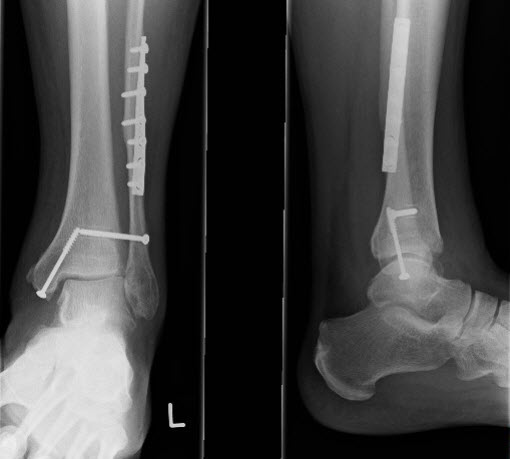A well-worn piece of writing advice says that everything reads better – and more memorably – if it is presented in groups of 3.
Following the “Rule of 3” could mean:
- having three brief sentences in succession;
- using three friendly, joyful (but mysterious) adjectives to describe something; or
- limiting your lists to three bullet points (!)
The ankle should be off to a good start in this context, given that there are 3 main bones in the ankle region. These are the talus – in the foot – and the tibia and fibula (in the leg).
In this article, we are going to have a look at ankle injuries.
Going back to first principles, we’ll start by defining what we mean by the ankle. Secondly, we’ll consider what are the most common types of ankle injury and their consequences. Finally, we will discuss the factors which affect the valuation of ankle injuries and the levels of compensation awards which tend to apply.
1. What do we mean by the ankle?
It may seem an obvious question with an easy answer: the ankle is where the foot and leg meet.
The main movements you can achieve through use of your ankle are dorsiflexion and plantar flexion. Dorsiflexion is the backward bending of the foot – where you lift your toes towards your leg, using your ankle. Plantar flexion is the opposite – where you use your ankle to move your toes downward, as if standing on tip-toe.
2. What are the most common ankle injuries?
The most frequently encountered injury is the sprained ankle. Usually, it’s an inversion injury – which means you go over on the outside of the foot in question.
A common cause of a fracture of the heel bone (calcaneus) is jumping from a height onto a hard surface. Instances of fractures of the heel bones of both feet in a single accident are not unusual.
We had a case for a dockworker who was supervising the unloading of a vessel by crane. In order to avoid being swept over the side by a low-swinging load, he had to jump overboard onto the quayside, breaking both heels on landing.
The most serious ankle fractures involve all three bones – known as trimalleolar fractures – and can leave lasting deformity. In the worst cases, there could be the risk that a further injury in that area would result in the foot having to be amputated.
Often, ankle fractures require treatment under general anaesthetic. The affected bone or bones may need to be internally fixed and held in position by means of metal plates and pins.

In serious cases, the injured person may have to undergo a subsequent arthrodesis of the ankle joint. This means that the joint is surgically immobilised by fusion of the bones. Where the ankle joint is treated in this way, it can help with relief of pain but it means that certain activities may become practically impossible. The direct effects of arthrodesis can include:
- inability to undertake heavy manual activity,
- inability to work in confined spaces,
- inability to climb ladders or stepladders with any confidence, and
- difficulty walking on uneven ground.
3. How much are ankle injuries worth?
The guidance which provides the ballpark figures used by insurers and solicitors in valuing the “pain and suffering” (solatium) element of personal injuries is contained in the Judicial College Guidelines.
For ankle injuries, in Scotland, suggested valuations range up to about £53,000 for solatium for the most serious fracture situations, as described above.
Factors (sorry – there’s more than 3 of them) which will affect the level of valuation include:
- the length of the treatment and amount of time spent in plaster;
- whether plates and pins have been inserted, and whether they cause any ongoing irritation to the injured person;
- whether there is any residual instability of the ankle joint (e.g. a tendency for the ankle to give way);
- the presence of, or future risk of, osteoarthritis;
- whether the injured person’s sleep is regularly disturbed by ongoing pain in the joint;
- the presence of any residual scarring;
- the impact of the injury on the person’s employment and employability;
- any need to wear special footwear or an orthotic insert; and
- whether the injured person has difficulty in walking on uneven ground, or in standing or walking for long periods of time, or in negotiating stairs.
With less serious, minor or undisplaced fractures, sprains or injuries to ligaments, where you make a full recovery (with no ongoing symptoms or scarring), the injury valuation is unlikely to exceed about £6,000 under Scots Law.
Indeed, according to the JC Guidelines, if you make a complete recovery from an ankle injury within a year of your accident, the recommended maximum for the injury part of your claim is about £4,200.
How we can help
We hope you found this article about ankle injury claims to be interesting, useful and informative.
If you have any questions arising from this post – or about any aspect of our personal injury claims services generally – please get in touch with us. You can contact Peter or Marie on 01343 544077 or by sending us a Free Online Enquiry via this website.
Make A Free Online Enquiry Now
Post Header image via Raka Rachgo on Unsplash.
